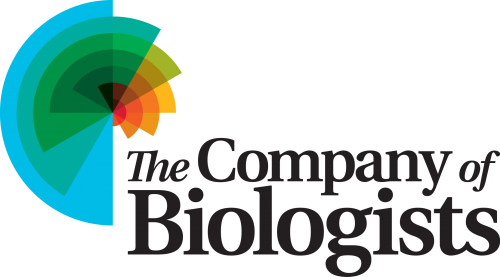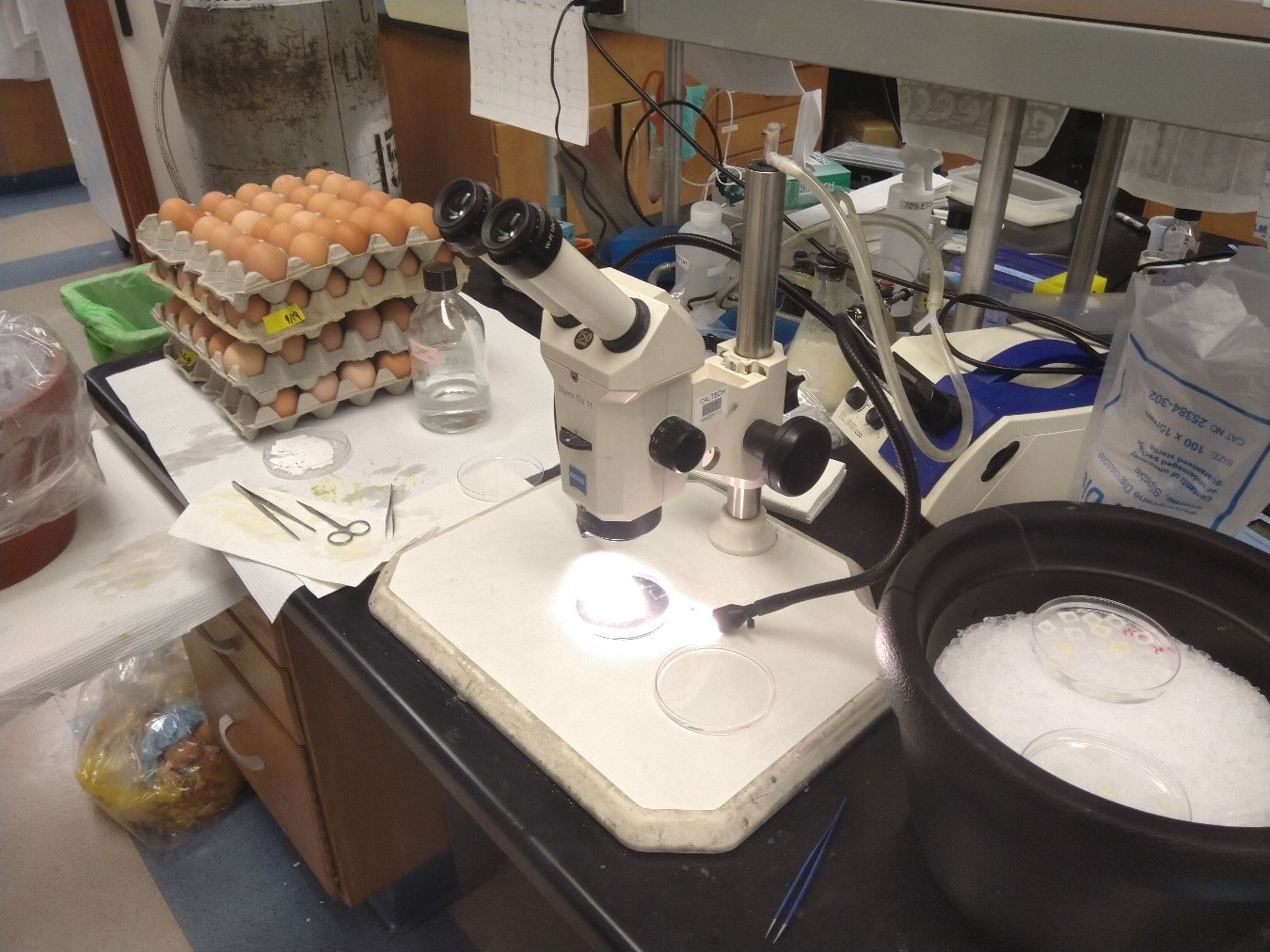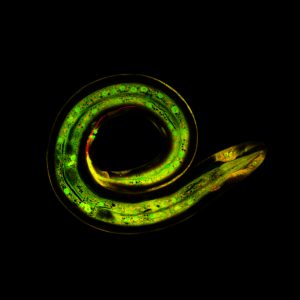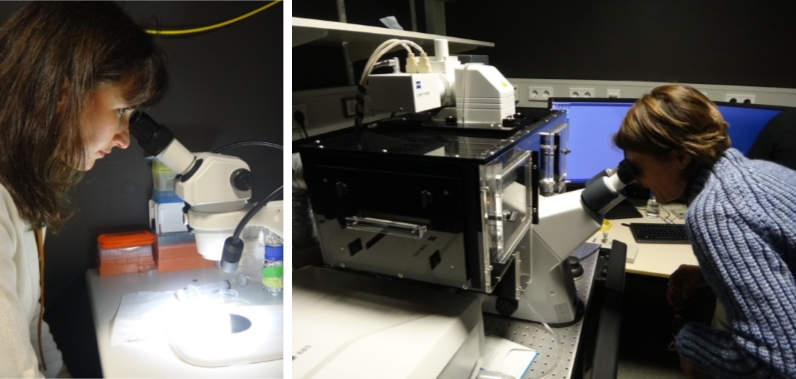Competitive recruitment for doctoral contracts 2019 – IBDM, Marseille, France
Posted by Delphine Dauga, on 28 March 2019
Closing Date: 15 March 2021
2019 PhD Projects @ IBDM :
Investigating basic principles of tumor hierarchy in Drosophila
Tumors are often heterogeneous, composed by different cell types that exhibit a hierarchical organization reminiscent to developing tissues. At the top of the hierarchy lie Cancer Stem Cells (CSCs) that have the ability to undergo unlimited self-renewal, to propagate tumor growth, but also to differentiate in different cell types to generate cellular heterogeneity. The balance between self-renewal and differentiation determines the speed of tumor growth as well as the proportion of CSCs. The mechanisms that instruct CSCs to self-renew or differentiate are unclear, but it is suspected that the redeployment of developmental programs could be involved.
In the lab, we take advantage of our deep understanding of how the Drosophila brain is built during development to explore how perturbation of these mechanisms can trigger tumorigenic growth. We combine single-cell transcriptomics, numerical modeling and the powerful genetic tools available in Drosophila to investigate how coopted neuro-developmental programs regulate the growth and heterogeneity of neural tumors. Using these approaches, we have uncovered several signaling pathways that are specifically active in a sup-population of CSCs in a model of neural tumors. Such pathways are conserved in mammals but their role in cancer is unclear.
The aim of the project is to decipher how genetic manipulations of these pathways affect the population of CSCs and tumor growth. This will involve generating new Drosophila transgenic lines, immunochemistry, confocal microscopy as well as new single cell transcriptomic approaches. We hope to provide new perspectives for the elimination or control of CSC populations in human.
Contact: cedric.maurange@univ-amu.fr
———————
Mechanisms of tumor-induced neural plasticity
Scientific background. A long neglected component of the tumor microenvironment are the neurons of the peripheral nervous system. The presence of neural fibers in tumors is now well established but their origin and functional impact on disease progression remain poorly understood. Our team is studying how the different branches of the peripheral nervous system (sympathetic, parasympathetic, enteric and sensory) contribute to the development and spread of pancreatic cancer (PC). Our recent work has revealed significant plasticity and remodeling of the sympathetic fibers that innervate pre-tumor and tumor lesions in mouse models of PC.
Objectives. The main objective of this PhD will be to study the molecular signaling pathways that regulate tumor-induced neuronal plasticity and to test how interfering with this process may affects tumor growth and metastatic progression.
Methods. The team developed new methods for quantitative analysis of neural networks in the entire mouse pancreas. These approaches combine whole-organ clearing and 3D imaging by light sheet fluorescent microscopy (LSFM). An image analysis workflow has been set-up to calculate parameters describing neural network structures and interactions with the main cellular components of the tumor microenvironment. Candidate signaling pathways, including neurite outgrowth and axon guidance pathways, will be identified and validated in vivo using neutralizing antibodies. Tumor growth and the occurrence of metastasis will be investigated by histopathological analysis and bioluminescence imaging.
Expected results. The results of the study will shed new light on the interactions between the nervous system and tumors and will identify potential therapeutic targets for modulating tumor innervation in PC.
Candidate profile. The project is at the intersection of neurobiology and oncology. We are looking for a highly motivated candidate with a solid scientific understanding of molecular and cellular biology and a good knowledge of statistics for biological research.
Crosstalk between cancer and immune cells in triple-negative breast cancer: uncover molecular mechanisms to design molecular therapies.
Topics. This PhD project has been designed as a co-direction thesis between CRCM/IPC (Borg-Team) and IBDM (Maina-Team) to study molecular and biological aspects linked to Triple-Negative Breast Cancer (TNBC). It is based on the use of a unique mouse genetic setting (MMTV-R26Met) recapitulating several molecular/biological TNBC features, including: a) intra-/inter-tumoural heterogeneity; b) resistance to treatments used in clinic; c) lung metastasis. Moreover, MMTV-R26Met TNBC display inflammatory background with infiltrating immune cells, including Tumour-Infiltrating-Lymphocytes, regulatory-T-cells, cytotoxic-T lymphocytes. These findings together with proteomic/RNA-seq outcomes indicate the existence of a crosstalk between cancer and immune cells recapitulated in MMTV-R26Met TNBC model.
Objectives. The PhD student will apply multi-disciplinary strategies to explore the crosstalk between cancer and immune cells during the formation/evolution of TNBC and its reprogramming during tumour regression following anticancer treatment, focussing on two complementary objectives.
1) An unbiased analysis of screen outcomes to extract molecular components of the cancer-immune cell crosstalk. The student will analyse transcriptome/proteomic data from MMTV-R26Met TNBC model at distinct tumorigenic states to: a) uncover signals belonging to the cancer-immune cell crosstalk; b) follow the dynamics of their expression changes; c) integrate findings with human cancer databases, exploring the existence of patient-subtype signatures. The student will analyse functional relevance of crosstalk components through gain-/loss-of-function studies using MMTV-R26Met TNBC cells.
2) Explore a candidate mechanism implicating the PTK7-EphA2 receptor axis on cancer-immune cell crosstalk, a new putative circuit emerging from Borg Team studies. Interestingly, the MMTV-R26Met TNBC model recapitulates this signalling crosstalk as PTK7 and EphA2 are upregulated in tumours. The student will analyse this circuit in cancer and immune cells both in MMTV-R26Met TNBC and sample patients from IPC. Moreover, studies will highlight modulation of this circuit during the tumorigenic program and following treatment. Combined therapies targeting both receptors will be tested in vitro/in vivo.
Methodologies. The PhD student will acquire several competences by applying complementary strategies: 1) bioinformatics to analyse screen outcomes and to integrate human cancer databases; 2) histological/FACS analyses to characterize immune cells in tumours; 3) molecular biology, biochemistry, proteomics, to explore cancer-immune cell crosstalk components; 4) gain-/loss-of function studies to assess functionality.
Expected results. Identify the cellular/molecular components of cancer-immune cell crosstalk during tumour onset, evolution, and regression following treatment. Design/test combinatorial treatments in preclinical models combining anticancer drugs with immune-therapy.
Candidate profile. Highly motivated candidate for a challenging project, with strong interest on cancer biology, and interested to apply approaches spanning from cultured cells, tissues analyses, and cancer mouse models. The student will be exposed to a scientific environment that stands out for interdisciplinary expertise.
Contact: flavio.maina@univ-amu.fr
———————
Molecular control of intercellular junction remodeling during radial intercalation
Scientific background
The insertion of individual mesenchymal cells into an epithelial sheet (radial intercalation) occurs during embryonic development, adult tissue homeostasis, and dissemination of metastatic carcinoma cells. Nevertheless, its control mechanisms remain poorly understood. In particular, little attention has been devoted to the role played by the ‘accepting’ epithelial cells.
The epithelium of the amphibian Xenopus laevis is a simple and accessible model system to study radial intercalation. During the development of this tissue, mesenchymal multiciliated cells (MCCs) undergo a short apical migration to intercalate into an epithelial layer in correspondence of junctions among at least three cells (aka vertices).
Objectives
In this PhD project, it is proposed to investigate the role played by outer layer epithelial cell cytoskeleton and intercellular junctions in the process of MCC intercalation. We have recently identified the signal triggered by the tyrosine kinase receptor KIT and its ligand SCF as a guidance system that controls the directionality of MCC movements during the intercalation process and their correct homing to outer layer vertices. KIT is expressed in intercalating MCCs, while outer layer cells express a transmembrane form of SCF. The PhD candidate will investigate whether a cell-autonomous signal initiated by SCF plays a role in opening outer layer intercellular junctions to accommodate intercalating MCCs.
Methods
Antibodies and custom–made fluorescent reporter constructs under the control of the outer layer-specific promoter of Xenopus nectin will be used to monitor the status of intercellular junctions and cytoskeletal components at different time points during the process of MCC intercalation through time-lapse confocal microscopy. Constructs coding for dominant-negative forms of cytoskeletal or intercellular junction proteins will be used to assess the role of these structures in MCC intercalation. To explore the possibility that SCF is cell-autonomously required for opening the outer-layer intercellular junctions, we will use nectin promoter-based fluorescent reporter constructs to study the dynamics of cytoskeleton and intercellular junctions following morpholino-mediated depletion of SCF.
Impact
The results obtained will clarify the contribution of epithelial cells to the process of
radial intercalation of mesenchymal cells, and shed new light on the mechanisms underlying signaling by the SCF/KIT pathway during development and metastasis.
Expected profile of the PhD candidate
The PhD candidate must have a strong background in one or several of the following disciplines: cell biology, developmental biology, biochemistry, biophysics. He or she must have a keen interest for quantitative biology and real-time imaging.
Contact: laurent.kodjabachian@univ-amu.fr
———————-
Quantitative analysis and simulation of fluid flows powered by cilia in vivo
Scientific background
Ciliated epithelia are present throughout evolution and serve functions ranging from locomotion of marine larvae to mucociliary clearance of pathogens from human airways. These functions are supported by the coordinated beating of myriads of motile cilia at the surface of multiciliated cells (MCCs), which generates robust and regular waves of fluid. The production of such waves depends on multiple parameters integrated across micrometric to millimetric scales, such as MCC density and cilia orientation. These parameters can be adequately studied in the larval mucociliary skin of the amphibian Xenopus, which is organized like the human airway epithelium, but is much easier to manipulate and film. This project will bridge the gap between biology, physics and numerical simulation to bring a new perspective to the understanding of respiratory diseases characterized by altered cilia-driven mucociliary transport, such as COPD or cystic fibrosis.
PhD Objectives
The aim of this interdisciplinary PhD project is to link quantitative experimental analysis to numerical simulation to build a global model of ciliated epithelium organization and activity. The ambition is to generate a multi-parametric model able to explain the emergence of cilia-driven fluid flows at the level of an entire organ. To this aim quantitative live imaging of cilia will be implemented on the 3D Xenopus embryo, which has never been done before. Numerical models will be challenged in silico and through experiments to test their predictive capacity.
Proposed approach
Live imaging: The PhD student will adapt light-sheet microscopy to film fluorescent beating cilia in all MCCs of the Xenopus embryo at various developmental stages.
Image processing: Biophysical analysis will be applied to extract quantitative information regarding cilia beating frequency and orientation, so as to build a global map of the embryo.
Numerical simulation: The quantitative experimental parameters thus acquired will be used to feed Lattice Boltzmann-based simulations, with the aim of generating numerical paradigms to explain the emergence of metachronal ciliary beat waves and spatial flow patterns.
Validation: In silico challenges (changes in ciliated cell density or orientation) will be introduced to predict outcomes on flow patterns, which will be verified through our experimental pipeline.
PhD student’s expected profile
The selected PhD student must have a keen interest in interdisciplinary and quantitative approaches to study biological problems. The ideal candidate will have a solid theoretical background in biological physics. Experience in microscopy techniques and image processing and a strong interest in modeling will be favorably considered.
Contact : olivier.rosnet@inserm.fr
———————
Role of TSHZ3 gene in the development and function of neuronal systems involved in autism spectrum disorder
State of the art
A collaborative study joining clinical and basic researchers, directed by two teams at the IBDM in Marseille (L. Fasano and L. Kerkerian-Le Goff), has linked an autism spectrum disorder (ASD) syndrome to heterozygous deletions of TSHZ3 gene. This gene codes for the TSHZ3 transcription factor, which is highly expressed in the cerebral cortex projection neurons (CPNs). Heterozygous deletion of Tshz3 in mouse (Tshz3+/-) leads to functional defects at corticostriatal synapses, changes in gene expression pattern as well as behavioral deficits mimicking ASD (reduced social interactions and fields of interest, stereotypies) (Caubit, Gubellini et al Nature Genetics 2016). We have also shown that postnatal Tshz3 deletion produces similar behavioral changes, but different gene expression changes and electrophysiological/synaptic defects at the level of the layer 5 CPNs and the corticostriatal pathway (Chabbert et al, Biological Psychiatry, in press). Interestingly, in this brain circuit TSHZ3 is expressed not only by CPNs but also by striatal cholinergic interneurons (CINs). This raises the issue about the respective role of these two neuronal populations in ASD, and of Tshz3 during pre- and postnatal development. To address this question we have generated several mouse models with conditional Tshz3 deletion.
Objectives
This project aims at elucidating the respective role of Tshz3 loss in CPNs vs. CINs in ASD deficits, and at studying their cellular and molecular substrates.
The specific objectives are:
1) Studying the functional consequences of Tshz3 conditional deletion on the electrophysiological and synaptic properties of CPNs and CINs (excitability, synaptic transmission/plasticity, etc.).
2) Establishing the gene expression profiles of these mice in order to provide a molecular basis for the electrophysiological and behavioral changes.
3) Evaluation whether or not the selective restauration of Tshz3 expression in one of these neuronal populations, in Tshz3+/- mice, can rescue the behavioral, cellular and molecular changes (“rescue” model)
Methods
This project is based on slice electrophysiology (patch-clamp) technique, as well as some immunohistochemistry and molecular biology.
Expected results
We expect that Tshz3 deletion or rescue in CPNs vs. CINs will produce specific changes at behavioral, molecular and electrophysiological level.
Expected candidate profile
The candidate should have a background in Neuroscience and be proficient with slice electrophysiology. Some experience with molecular biology and/or immunohistochemistry is also welcome.
Contact: paolo.gubellini@univ-amu.fr
———————
Uncover the interplay between signalling dynamics and cell mechanics during early fate determination of human induced pluripotent stem cells
Human induced pluripotent stem cells (hiPSCs) hold great promise for developmental biology studies and for regenerative medicine owing their ability to generate all cell types of three germ layers (endoderm, mesoderm, and ectoderm). Regulation of hiPSC differentiation relies on dynamic interaction between signalling and physical cues. At the signalling level, spatiotemporally regulated secreted proteins such as BMP, WNT, and ACTIVIN/NODAL induce different fates based on concentration and dynamics of presentation. Yet, physical cues such as cell-cell adhesion, cell shape and geometry, extracellular-matrix mechanics modulate cell fate specification and patterning by altering and/or shaping cellular responses to biochemical signals.
We propose to explore the spatial/temporal dynamic of instructive signals and physical cues governing mesoderm and endoderm lineage acquisition versus neuroectoderm by using hiPSCs down-regulated for the morphogen regulator, GLYPICAN4. The rational arises from our results showing that GLYPICAN4 controls self-renewal versus lineage entry of stem cells by fine-tuning self-renewal signals. We have also evidences for GLYPICAN4 as crucial regulator of neuroectoderm versus mesoderm and endoderm lineage diversification, as illustrated by enhanced propensity of GLYPICAN4 mutant hiPSCs (versus controls) to acquire mesoderm and endoderm fate in response to extracellular signals. Interestingly, undifferentiated GLYPICAN4 mutant hiPSCs display changes in cell-cell and cell-matrix interactions, which are reminiscence of an impaired epithelial-like structure of GLYPICAN4 mutant hiPSCs. Thus, GLYPICAN4 mutant hiPSCs are suitable as model system to explore mechanistically the crosstalk between mechanical properties and signalling processes that drives efficient differentiation of hiPSCs into the three embryonic layers.
For these studies, we will employ the micropatterning technology in which hiPSC, spatially confined onto circle geometry, differentiate to generate simultaneously neuroectoderm, mesoderm, and endoderm organized in adjacent domains with radial pattern. Segregation in these lineages requires quantitative intercalation of BMP, ACTIVIN, WNT signals in a precise temporal dynamics. Thus, we will apply these factors to hiPSC at different concentrations and time. We will analyse differentiation patterns by fluorescence marker imaging with state-of-art microscopy and computational image analysis as well as signal diffusion and receptor patterns at the plasma membrane. Micropatterns will be also used to study physical properties of undifferentiated and differentiating GLYPICAN4 mutant hiPSCs versus controls by performing mechanical measurements (by atomic force microscopy) and by molecular analysis of mechanosignals.
Results from this analysis should highlight how mechanical signals integrate with soluble signals to regulate embryonic specification by differentially modulating cell-cell and cell-matrix interactions and by establishing patterns of differential signal sensitivity in cells.
The candidate is expected to have strong interest in developmental and cell biology as well as expertise in hiPSC technologies.
Contact : rosanna.dono@univ-amu.fr
———————
Investigating the effects of re-expression of the Tshz3 gene in adult mouse brain on autistic behaviours
State of the art
We have established that the heterozygous deletion of the TSHZ3 gene in humans and mice causes autism spectrum disorders (ASD) (Caubit et al, Nat. Genet. 2016). Recently, we have shown that the conditional deletion of Tshz3 in the post-natal cerebral cortex induces autistic behaviours with changes in gene expression and functional defects in cortical projection neurons (CPNs) in layer V (L5) (collaboration with Lydia Kerkerian-Le Goff’s team; Chabbert et al, Biological Psychiatry, under revision). These results point to a critical postnatal function of Tshz3 in maturation and central nervous system (CNS) function, particularly in L5 CPNs. These data encouraged us to generate a Tshz3+/STOP mouse to restore Tshz3 function in a controlled way after crossing with a Cre lineage and test the ability to correct functional defects by restoring Tshz3 expression in the CNS after birth.
Objectives
1) Characterize the behaviour of Tshz3+/STOP heterozygous mice that should exhibit autistic-type behaviours such as Tshz3+/lacZ and Tshz3+/Deltaflox mice already tested.
2) Analyze the behavior of rescue mice produced by crossing Tshz3+/STOP mice with Cre mice (i.e. CamK2-Cre).
3) Identify the molecular pathways modified by the postnatal loss of Tshz3 and restored after “rescue” (RNAseq transcriptomic analysis).
4) Analyze the behavioral, molecular and functional consequences of the loss of Tshz3 function specifically in the CPNs of L5.
5) Identify the direct targets of the transcription factor TSHZ3 by in vivo chromatin immunoprecipitation approaches (ChIP; ChIP-seq).
Methods
This project focuses on genetic, transcriptomic and immunohistochemistry approaches (in vivo target validation). The functional analysis by electrophysiology will be carried out in collaboration with Lydia Kerkerian-Le Goff’s team.
Expected results
This project will determine 1) whether restoring Tshz3 expression after birth improves the behavior of Tshz3+/STOP mice; 2) identifying for the first time direct targets of TSHZ3; 3) identifying molecular targets relevant for the development of future therapeutic strategies for ASDs; and 4) specifying the contribution of Tshz3 loss of function in L5 CPNs to characteristic ASD phenotypes.
Expected candidate profile
The candidate should have training in neurobiology and practical experience in one of the techniques planned for the thesis. An experiment in mouse genetics would be beneficial but not mandatory.
Contact: xavier.caubit@univ-amu.fr
———————
impact of gut microbiota on host behavior and physiology
Scientific background
It is now very well established that gut-associated bacteria can impact the behavior and the physiology of their eukaryotic host. The PhD thesis project is aimed at using the powerful genetic tools available in the Drosophila model and the relative simplicity of its gut microbiota to study, at the molecular level, the molecular dialog between the microbiota and its host. In two recent publications, (Kurz et al, Elife, 2017: Charroux et al, Cell Host Microbe, 2018), the lab has shown that a metabolite produced by gut-associated bacteria, called peptidoglycan, can cross the gut epithelium and reach the insect blood where it interferes with various organs (fat body, ovaries, brain…) and modifies functions (behavior changes, organ wasting…). The PhD student will use the newest genome editing technologies (Crispr…), genetic tools and latest imaging microscopy technics to dissect the precise cellular and molecular mechanisms of the dialog that exist between gut-resident bacteria and some specific cells of the host. Recent results showing that mice deficient in peptidoglycan-sensing proteins exhibit social behavioral alterations suggest that the mechanisms that we study in Drosophila also exist in mammals.
Profile of the candidate
We look for an enthusiastic and ambitious student with a strong interest in the genetics of host-bacteria interactions. The candidate is expected to have a background in molecular biology and should hold a Master Degree in Bioscience Engineering, Biotechnology or Biology. The candidate should have a level of proficiency in English which is sufficient to communicate effectively with colleagues.
Contact: Julien.royet@univ-amu.fr


 (No ratings yet)
(No ratings yet) from a recipient of a Development Travelling Fellowship, funded by our publisher The Company of Biologists.
from a recipient of a Development Travelling Fellowship, funded by our publisher The Company of Biologists.
 (10 votes)
(10 votes)





